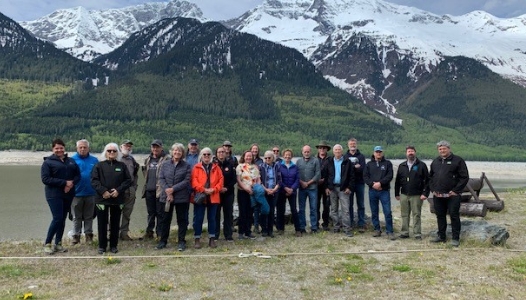Columbia River Treaty
Edition: April 2023

Columbia Basin Regional Advisory Committee visits Kinbasket Reservoir
Apr 5, 2023

Columbia Basin Regional Advisory Committee members standing on the shore of Kinbasket Reservoir, May 2022
Throughout its eight years together, the Columbia Basin Regional Advisory Committee (CBRAC) has held meetings all across the Basin. From Invermere near the Columbia River headwaters, to Castlegar at the confluence of the Columbia and Kootenay Rivers, and many locations in between. Each meeting is coupled with a field trip to a local site connected to the Columbia River Treaty in some way. Members have visited the Hugh Keenleyside and Duncan Dams and the Koocanusa Reservoir. They have also toured Revelstoke Dam and some of the hydropower facilities along the Kootenay River between Nelson and Castlegar, which are not part of the Treaty but are affected by its flow requirements.
The intent of moving around is to help members better understand how management of the Columbia and Kootenay Rivers affects different parts of the Basin in unique as well as similar ways, while highlighting that changing dam operations in one part of the region has an effect on the entire river system. This perspective supports the committee’s approach to providing advice on potential future improvements to the Columbia River Treaty and regional hydro operations in a way that considers the Basin as a whole.
Last May, after more than two years of pandemic-enforced virtual meetings, CBRAC came together in person again and it was a clear choice to meet, for the first time, in Valemount B.C. In addition to experiencing one of the more remote communities in the Basin, this provided members with the opportunity to visit the Kinbasket Reservoir; the largest reservoir in the upper Columbia Basin.
Kinbasket Reservoir was created by the Mica Dam, the third Treaty dam to be built in B.C., and is located 140 kilometres north of Revelstoke. It stretches 216 kilometres from north of Golden to south of Valemount and provides 12 million-acre feet of water storage. It has a drawdown range of approximately 150 feet (45.7 metres) and is essential for preventing damaging floods downstream along the Columbia River, enabling power generation in B.C. and increasing power generation in the U.S.
For its field trip, CBRAC travelled to the Valemount Marina located 30 kilometres from the village, on the east side of the reservoir. The visit was intentionally scheduled for when water levels were drawn down, as they are each year at that time, after producing electricity during the cold winter months and to make room for the spring freshet (inflows from melting snowpack). Members looked around at the exposed landscape and were shown the location of the Canoe River hot springs south of the marina, accessible only when the reservoir’s elevation is low enough at around 720 metres above sea level.
The group gathered in a circle to hear stories and perspectives from those with ties to the region. Nathan Matthew of the Secwepémc Nation spoke about the Secwepémc people‘s history in this part of their territory and their deep connection to the land. Mayor Owen Torgerson and Councillor Donnie MacLean shared stories of the Valemount community, before and after the reservoir was formed. They all remarked on the affect Mica Dam and its reservoir has had on the plants, animals and people of the area.
Through the conversations that followed, CBRAC members talked about Kinbasket Reservoir’s effect on the natural environment, Indigenous cultural values, and recreation opportunities, while at the same time enabling generation of a significant portion of GHG-free hydroelectricity in B.C.
CBRAC had time to walk around, take photos and reflect on what they had learned. Everyone remarked on how powerful it was to see the reservoir for themselves – photos can only convey so much.
The committee returned to town and convened their meeting, bringing with them a new, personal connection to this part of the Basin, and a greater appreciation for the complexity of modernizing the Treaty.


